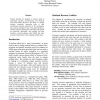AAAI
1998
14 years 1 months ago
1998
Sketchy planners are designed to achieve goals in realistically complex, time-pressured, and uncertain task environments. However, the ability to manage multiple, potentially inte...
AAAI
2000
14 years 1 months ago
2000
This paper demonstrates qualitative spatial reasoning techniques in a real-world diagrammatic reasoning task: Course-of-Action (COA) diagrams. COA diagrams are military planning d...
AAAI
2000
14 years 1 months ago
2000
A central problem in qualitative reasoning is understanding how people reason about space and shape with diagrams. We claim that progress in diagrammatic reasoning is being slowed...
AAAI
1998
14 years 1 months ago
1998
People frequently complain that it is too difficult to figure out how to get computers to do what they want. However, with a computer system that actually tries to understand what...
AAAI
2000
14 years 1 months ago
2000
In this paper, we present PQSOLVE, a distributed theorem-prover for Quantified Boolean Formulae. First, we introduce our sequential algorithm QSOLVE, which uses new heuristics and...
AAAI
1998
14 years 1 months ago
1998
Weexaminethree heuristic algorithms for gameswith imperfect information: Monte-carlo sampling, and two newalgorithms wecall vector minimaxingand payoffreduction minimaxing. Wecomp...
AAAI
1998
14 years 1 months ago
1998
For mobile robots to be successful, they have to navigate safely in populated and dynamic environments. While recent research has led to a variety of localization methods that can...
AAAI
2000
14 years 1 months ago
2000
The complexity of numerical domain partitioning depends on the number of potential cut points. In multiway partitioning this dependency is often quadratic, even exponential. There...
AAAI
1998
1998
Using Artificial Intelligence Planning to Automate SAR Image Processing for Scientific Data Analysis
14 years 1 months ago
AAAI
2000
14 years 1 months ago
2000
We consider the compilation of different reasoning tasks into the evaluation problem of quantified boolean formulas (QBFs) as an approach to develop prototype reasoning systems us...

